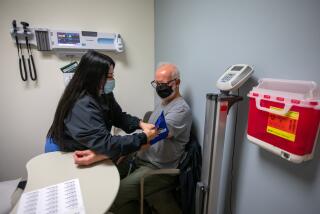‘Doctor’s Dilemma’ director Dámaso Rodriguez
Every now and then, a play or song or book comes around that perfectly encapsulates the time we live in, despite having been created decades, or even centuries, ago.
Such is the case with George Bernard Shaw’s “The Doctor’s Dilemma,” which was first staged in 1906 and recently wrapped its run at Pasadena’s A Noise Within theater. The show touches on morality in medicine and on who should be saved and who gets turned away when resources are scarce.
Here, director Dámaso Rodriguez talks to us about the play’s current relevance, the heart of its story and the reason it’s being put on now.
Tell me about the play.
It’s a rarely produced George Bernard Shaw play. He wrote it as kind of a scathing satire of the medical profession, so it has all these references to medical procedures and philosophies that are ripped from the headlines of its day.
In addition to being scathing, though, it’s a compelling story. A doctor has been knighted for discovering this cure for tuberculosis, and he’s doing an experimental test case and being approached by lots of people to take on their cases. What it comes down to is he has one slot left, and he needs to treat either this very talented young artist or an old friend who is, relatively speaking, a mediocre doctor.
The play examines who is worth saving, the doctor’s power, and Shaw puts this twist in where the wife of the young artist is extremely beautiful and the doctor has fallen for her, so if he lets the artist die he can potentially marry his widow.
What made you want to put the show on now?
The play was first selected for the season by the artistic director at A Noise Within and offered to me. It’s extremely timely — surprisingly so — and it’s not very commonly produced. In light of everything that’s going on right now in terms of Obama’s healthcare plan and the insurance industry, the play kind of can’t help but reflect that moment in a way. It’s shockingly relevant.
How does this speak to healthcare issues today?
It forces you to think about why things are driven by money in large part when it comes to people’s health and lives. In this case, people are unable to care for themselves and pay for available treatment, so one person is going to die.
You are forced to think about it and talk about it and think about how we came to this place where those kinds of choices are made every day. Someone doesn’t have insurance and can’t get the care they need when it’s readily available.
What motivates the doctor in question?
He gets his colleagues together, and they are going to evaluate the worth of the individual, and that leads to a whole other discussion about the value of lives and who is going to make the most out of life if they are saved.
What of course happens in the play is that the artist is undeniably brilliant, but then you find out that he’s a terrible person. He’s a bigamist, he’s in massive amounts of debt, he’s constantly borrowing money and lives in his own moral code. This person who produces art is a bad human — that becomes a true dilemma.
How did you research the show?
We consulted with a board member, how would someone literally check somebody out in the medical profession. There is also a lot of material in the play that tells you about the profession, and Shaw was basing everything on personal interactions with friends who were doctors. On top of that, he wrote a hundred-page preface to the play, which was a scathing commentary.
More to Read
The biggest entertainment stories
Get our big stories about Hollywood, film, television, music, arts, culture and more right in your inbox as soon as they publish.
You may occasionally receive promotional content from the Los Angeles Times.










